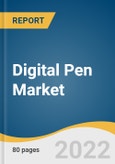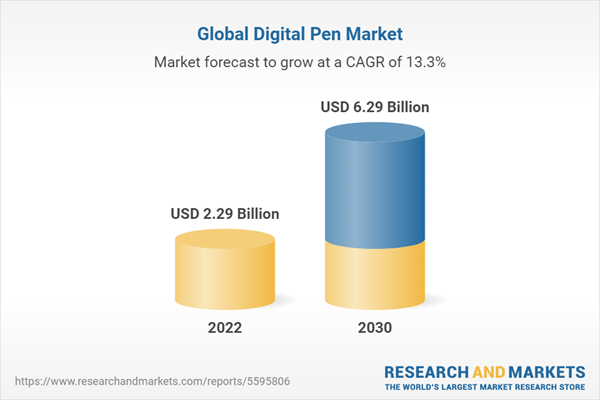The global digital pen market is expected to reach USD 6.29 billion by 2030, at a CAGR of 13.3%. The growth of the market is majorly driven by the growth in internet penetration and the rise in the adoption of smart devices coupled with an increase in the adoption of byOD policy. Furthermore, a rise in the adoption of business process automation is anticipated to drive market growth.
The digital pen is a writing application equipped with a battery and scanning solution that allows users to capture handwritten documents and drawing in digital form. Further, few digital pens are equipped with handheld scanners that are intended to use optical character recognition to turn printed text into editable text on computer applications. In addition, the rise in the utilization of smart infrastructure solutions such as smart pens and digital art pens across commercial and manufacturing sectors is anticipated to drive the digital pen market.
The coronavirus pandemic has left an indelible mark on education systems all over the world. The paradigm shift to remote countries has accelerated access to devices and broadband internet across the country. Wacom, a Japanese device manufacturer, announced that its digital pen tablet is now fully compatible with Google OS and Chromebooks. During the pandemic, the two most recent trends in digital transformation in the education industry have been the expansion of distance education and the rise of educational technology innovations.
The integration of a digital pen and paper system is a new technology that must overcome these constraints. A slew of new technologies for clinical documentation has emerged. These include barcode systems, speech recognition systems, pen-based systems, as well as scanning technology. Existing technology for documentation and data entry has proven to be problematic over the years.
According to the National Center for Biotechnology Information, U.S. National Library of Medicine, usability testing was conducted to evaluate the new technology, and a digital pen and paper system would be integrated for hospital nurses. The research study concluded that because existing technologies for documentation and data entry are problematic, most computer interactions require the use of a keyboard and mouse, which are unsuitable for bedside nursing. As a result, the demand for digital pens outnumbers the demand for traditional pens and paper in clinical documentation. Such factors have a positive impact on the ultimate growth of the handwriting digital pen market.
North America accounts for the largest market share in the market as the citizens in this region are tech-savvy, and the adoption of smart devices in the US and Canada is high as compared to other countries. Europe holds the second largest market share in the digital pen market as the countries in this region including Germany and the UK are making rapid innovations in automotive and electronic industries.
For instance, in US and Germany, the police officers and other authorities use these pens to generate intelligence and crime reports, as it saves time by recording information on a device and transferring it to a computer or sharing it through various connecting technologies. Asia-Pacific is expected to be the fastest-growing market as companies are largely investing in digital technology tools to save effort as well as time. The digital pen market in the Middle East and Africa, and Central and South America are in a nascent stage but are expected to show significant growth during the forecast period. However, a lack of technology readiness across various underdeveloped nations may limit the growth of this market.
The digital pen is a writing application equipped with a battery and scanning solution that allows users to capture handwritten documents and drawing in digital form. Further, few digital pens are equipped with handheld scanners that are intended to use optical character recognition to turn printed text into editable text on computer applications. In addition, the rise in the utilization of smart infrastructure solutions such as smart pens and digital art pens across commercial and manufacturing sectors is anticipated to drive the digital pen market.
The coronavirus pandemic has left an indelible mark on education systems all over the world. The paradigm shift to remote countries has accelerated access to devices and broadband internet across the country. Wacom, a Japanese device manufacturer, announced that its digital pen tablet is now fully compatible with Google OS and Chromebooks. During the pandemic, the two most recent trends in digital transformation in the education industry have been the expansion of distance education and the rise of educational technology innovations.
The integration of a digital pen and paper system is a new technology that must overcome these constraints. A slew of new technologies for clinical documentation has emerged. These include barcode systems, speech recognition systems, pen-based systems, as well as scanning technology. Existing technology for documentation and data entry has proven to be problematic over the years.
According to the National Center for Biotechnology Information, U.S. National Library of Medicine, usability testing was conducted to evaluate the new technology, and a digital pen and paper system would be integrated for hospital nurses. The research study concluded that because existing technologies for documentation and data entry are problematic, most computer interactions require the use of a keyboard and mouse, which are unsuitable for bedside nursing. As a result, the demand for digital pens outnumbers the demand for traditional pens and paper in clinical documentation. Such factors have a positive impact on the ultimate growth of the handwriting digital pen market.
North America accounts for the largest market share in the market as the citizens in this region are tech-savvy, and the adoption of smart devices in the US and Canada is high as compared to other countries. Europe holds the second largest market share in the digital pen market as the countries in this region including Germany and the UK are making rapid innovations in automotive and electronic industries.
For instance, in US and Germany, the police officers and other authorities use these pens to generate intelligence and crime reports, as it saves time by recording information on a device and transferring it to a computer or sharing it through various connecting technologies. Asia-Pacific is expected to be the fastest-growing market as companies are largely investing in digital technology tools to save effort as well as time. The digital pen market in the Middle East and Africa, and Central and South America are in a nascent stage but are expected to show significant growth during the forecast period. However, a lack of technology readiness across various underdeveloped nations may limit the growth of this market.
Digital Pen Market Report Highlights
- Digital pen with handwriting ability is projected to register the highest market share owing to the increasing demand among millennials and Gen Z. Under handwriting digital pens, the fastest growing sector is Stylus.
- Tablet is anticipated to register faster growth during the forecast years with a CAGR of 13.8% from 2022 to 2030 due to rising demand for it instead of smartphones and PCs.
- The BFSI sector is expected to witness the fastest growth owing to the rapidly changing environment of the sector to improve customer services. Furthermore, it helps in reducing the labor and time consumed in the process of moving the data from analog to digital versions.
- North America was the largest market, accounting for more than 37.0% share of the global revenue in 2020. The rapid adoption of the digital pen in countries such as the U.S. and Canada as a result of increased diffusion of digital technologies in the majority of businesses is a key factor driving the market.
Table of Contents
Chapter 1. Methodology and Scope
Chapter 2. Executive Summary
Chapter 3. Digital Pen Market Variables, Trends & Scope
Chapter 4. Consumer Behavior Analysis
Chapter 5. Digital Pen Market: Product Estimates & Trend Analysis
Chapter 6. Digital Pen Market: Usage Estimates & Trend Analysis
Chapter 7. Digital Pen Market: End-users Estimates & Trend Analysis
Chapter 8. Digital Pen Market: Regional Estimates & Trend Analysis
Chapter 9. Competitive Analysis
Chapter 10. Company Profiles
Companies Mentioned
- Iris S.A.
- Lucidia Inc.
- Kent Displays
- Wacom Co. Ltd.
- Acecad Digital Corp.
- Neolab Convergence Lab
- Livescribe Inc.
- Moleskine S.P.A
- Apple Inc.
- Microsoft Inc.
Methodology

LOADING...
Table Information
| Report Attribute | Details |
|---|---|
| No. of Pages | 80 |
| Published | April 2022 |
| Forecast Period | 2022 - 2030 |
| Estimated Market Value ( USD | $ 2.29 Billion |
| Forecasted Market Value ( USD | $ 6.29 Billion |
| Compound Annual Growth Rate | 13.3% |
| Regions Covered | Global |
| No. of Companies Mentioned | 10 |









